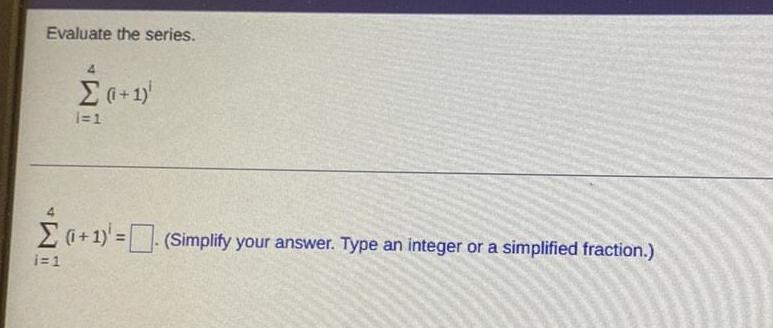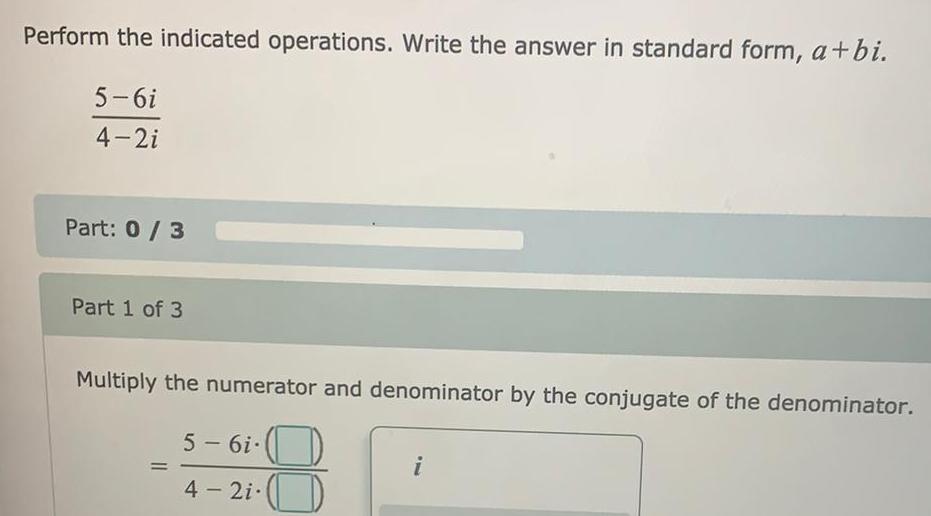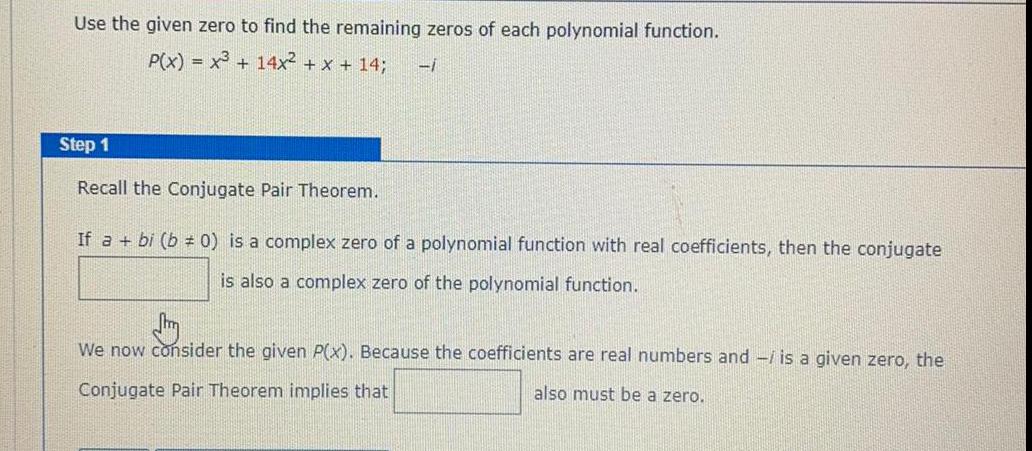Complex numbers Questions and Answers

Math
Complex numbersSelect the correct expressions in the table Which expressions are equivalent to the given expression 9 4 2 576 64 32i2 24 8i 3 2i 2 24 8i 32i2 24 8i 51 6i 45 101 51 6i

Math
Complex numbersFind the complex zeros of the following polynomial function. Write f in factored form.
f(x)=x³ +27
The complex zeros of f are
Use the complex zeros to factor f
f(x) =

Math
Complex numbersFind Z₁ Z₂, and
if z₁ = 2( cos 45° + i sin 45°) and Z₂ = 4( cos 25° + i sin 25°). Write your answers in standard polar form with the argument in degrees.

Math
Complex numbersFind zw and Write each answer in polar form and in exponential form.
The product zw in polar form is
and in exponential form is

![Use DeMoivre's Theorem to calculate the following expression. Express your answer in the form found using Euler's Formula. |z|n ein0
[3 (cos(240°) + isin (240°))]8](https://media.kunduz.com/media/sug-question/raw/77166412-1660225412.0373392.jpeg?w=256)
Math
Complex numbersUse DeMoivre's Theorem to calculate the following expression. Express your answer in the form found using Euler's Formula. |z|n ein0
[3 (cos(240°) + isin (240°))]8

Math
Complex numbersWrite the following complex number in standard form, z = a + bi. Use the exact form if possible; otherwise, use a decimal approximation rounded
to the hundredths place.
5 (cos(315°) + isin (315°))

Math
Complex numbersPerform the following division and write the quotient in trigonometric form. Write the magnitude in exact form. Write the argument in radians and
round it to two decimal places if necessary.
-6i/ 2+i

Math
Complex numbersPerform the following multiplication and write the product in standard form. Express your result in the exact form, if possible; otherwise, use a decimal approximation rounded to the nearest hundredth.
(-1-3i)(-2+3i)

Math
Complex numbersWrite the following complex number in trigonometric form. Write the argument in radians, and if possible, use the exact form. Otherwise, use a
decimal approximation rounded to the hundredths place.
-4-2i

Math
Complex numbersEvaluate the series.
4Σ (i+1)
i=1
i=14Σ (i+1) = (Simplify your answer. Type an integer or a simplified fraction.)

Math
Complex numbersSolve the following equation in the complex number system. Express solutions in both polar and rectangular form.
x³-(3-√2+3√/2i)=0
Write the solutions as complex numbers in polar form. Choose the correct answer below.
A 3√6 (cos 15°+ i sin 15°). 3√6(cos 135°+ i sin 135°). 3√6 (cos 45°+ i sin 45°)
B 3√6 (cos 15° + i sin 15°), 3√6(cos 135°+ i sin 135°). 3√6(cos 255°+ i sin 255°)
C. 6(cos 15°+ i sin 15°), 3√6(cos 45°+ i sin 45°), 6(cos 255° + i sin 255°)
D.3√6(cos 15°+ sin 15°), 3√6(cos 135°
sin 135°), 3√6(cos 45°+ i sin 45°)

Math
Complex numbersWrite the complex number in trigonometric form r( cos0+ i sin 0), with 0 in the interval [0°,360°).
-1-i -1-i=(cos + i sinº)


Math - Others
Complex numbersWhich of the following simplified does not contain an imaginary number?
a) √(-49)
b)(1+i) (7 – 4i)
c)(2+i) (2-i)
d)(3+i)^2

Math
Complex numbersWrite the complex number in rectangular form. 6 cis 135°
6√3 + 3i√3
-3√2+ 3i√2
6√2 - 3i√2
3√2 - 3i√2

Math
Complex numbersPerform the indicated operations. Write the answer in standard form, a+bi.
5-6i/4-2i
Multiply the numerator and denominator by the conjugate of the denominator.
5-6i-()/
4- 2i.()
i

Math
Complex numbersWrite the standard form of the complex number
8(cos(60°) + i sin(60)
Plot the complex number

Math
Complex numbersThe ______of the complex number z = a + bi is z = r(cos(θ) + i sin(θ)), where r is the ______of z.and θ is________

Math
Complex numbersFill in the blank __________Theorem states that if z = r(cosθ + isinθ) is a complex number and n is a positive integer, then z^n = r^n (cos nθ + i sin nθ).

Math
Complex numbersUse DeMoivre's Theorem to find the indicated power of the complex number. Write the result in standard form.
(4 + 4i)^6

Math
Complex numbersUse the given zero to find the remaining zeros of each polynomial function.
P(x) = x³ + 14x² + x + 14;
Step 1
Recall the Conjugate Pair Theorem.
If a + bi (b ≠ 0) is a complex zero of a polynomial function with real coefficients, then the conjugate is also a complex zero of the polynomial function.
We now consider the given P(x). Because the coefficients are real numbers and - is a given zero, the Conjugate Pair Theorem implies that ___also must be a zero.

Math
Complex numbersFind an nth degree polynomial function with real coefficients satisfying the given conditions.
n=3; 2 and 3 + 2i are zeros: leading coefficient is 1
A. f(x)= x³ + 5x² + 25x - 14
B. f(x) = x³ - 8x² + 25x - 26
C. f(x)=x² - 4x² + 25x - 26
D. f(x)=x³8x² + 15x-26
![If R=(√2+1)^2n+1 where [R] and f = R-[R] denotes the greatest integer function and fractional part of R respectively, then the value of [R] is equal to:
f+1/f
f-1/f
1/f-f
None of these](https://media.kunduz.com/media/sug-question/raw/51108736-1658398716.7830956.jpeg?w=256)
Math
Complex numbersIf R=(√2+1)^2n+1 where [R] and f = R-[R] denotes the greatest integer function and fractional part of R respectively, then the value of [R] is equal to:
f+1/f
f-1/f
1/f-f
None of these

Math
Complex numbersLet z₁ = 6(cos 130° + i sin 130°) and z₂=2(cos 190° +isin 190°).
Find the following.
Write your answers in trigonometric form.
Give exact values in your answers (not decimal approximations).
(a) z1z2 =
(b) z1/z2 =

Math
Complex numbersGiven Z1 = 3+0i and 22 = -1- 2i, calculate the product z1z2 and express all
three complex numbers in polar form, rounding all angles to the nearest degree in
the interval 0° 0 < 360°. Express all moduli in simplest radical form.

Math
Complex numbersWrite the complex number z=-2-4i in trigonometric form (sometimes called polar form). Express the angle θ in radians, where 0≤θ<2π.
Do not round any intermediate computations, and round the values in your answer to the nearest hundredth.


Math
Complex numbersEvaluate the expression - 3+1i/5i and write the result in the form a + bi.
The real number a equals
The real number b equals

Math
Complex numbersWrite each power of 1+i in the form a + bi, where a and b are real numbers. If a or
bis zero, you can ignore that part of the number. For example, 0+3i can simply be
expressed as 3i.
a. (1 + i)⁰
b. (1 + i)¹
c. (1 + i)²
d. (1 + i)³
e. (1 + i)4

Math
Complex numbersFor the following function, one zero is given. Find all the others.
tx)=x³-6x² +10x-8; 1-i
The zeros of f(x) are 1-i. __,and ___
(Simplify your answers. Type any nonreal complex zeros first. Type exact answers, using radicals and i as needed.)

Math
Complex numbersWrite the expression in rectangular form, x+y i, and in exponential form, reiθ
(√13-i)4
The rectangular form of the given expression is. and the exponential form of the given expression is
(Simplify your answers. Use integers or decimals for any numbers in the expressions. Round the final answer to three decimal places as needed. Round all intermediate values to four decimal
places as needed.)

Math
Complex numbersFind zw and z/w. Write each answer in polar form and in exponential form.
z=4( cos 2π/9 + i sin 2π/9)
w= 16 (cos π/9 + i sin π/9)

Math
Complex numbersConvert the complex number 1 - 8i into polar form. Express the angle using degrees over the interval 0° ≤ 0 < 360°. You may round the argument to the nearest tenth of a degree (if necessary), but you must express your modulus in it's exact form.

Math
Complex numbersFill in the type of market that matches each feature mentioned below.
Feature
Firm sets market price depending on other firm's market price.
Firms with zero ability to affect price.
A product with no close substitutes.

Math
Complex numbersConvert the complex number -9 + Oi into polar form. Express the angle using
degrees over the interval 0° ≤0 < 360°. You may round the argument to the
nearest tenth of a degree (if necessary), but you must express your modulus in it's
exact form.

Math
Complex numbersConvert the complex number 1 + 9i into polar form. Express the angle using degrees over the interval 0° ≤ 0 < 360°. You may round the argument to the nearest tenth of a degree (if necessary), but you must express your modulus in it's exact form.

Math
Complex numbersFind the following product and write the result in standard form, a + bi.
(-4+ i)(3+ i)
(-4+ i)(3+i)=


Math
Complex numbersThe additive inverse of a complex such that z + z = 0. The multiplicative that z + z a that z. z, such that z. Z = 1. Find the additive 'm number z is a complex number z such inverse of z is a complex number z such and multiplicative inverses of each complex number.

Math
Complex numbersComplex numbers are used to describe current, I, voltage, E, and impedance, Z. These three quantities are related by the equation E = IZ. Given two of these quantities, solve the equation E = IZ for the missing variable.
I=3+5i, E=2+7i
Z=
(Simplify your answer. Type your answer in the form a +bi. Use integers or fractions for any numbers in the expression.)


Math
Complex numbersWrite the complex conjugate of the complex number.
5 - 7i
Multiply the number by its complex conjugate. (Simplify your answer completely.)

Math
Complex numbersCheck each true statement about the number
7-√3i
7 is the real part of the number.
√3 is the imaginary part of the number..
7-√3 is the coefficient of t.
This number is the sum of a real number and an imaginary number.

Math
Complex numbersFind all complex solutions of 3x²+2x+5=0.
(If there is more than one solution, separate them with commas.)

Math
Complex numbersCan the following be factored? If so, factor it: 100x²+4y²
Yes. (10x +2y)(10x - 2y)
Cannot be simply factored.
Yes. (10x + 2i)(10x - 2i)
Yes. (10x + 2yi)(10x - 2yi)
Yes. 10(x+2yi)(x - 2yi)

Math
Complex numbersPerform the indicated operation and simplify. Write the answer in the form a+bi.
7-3i
4+5 i
7-3i 13
47 i
4+5i 41 41
(Simplify your answer. Use integers or fractions for any numbers in the expression.)

Math
Complex numbersSuppose that R(x) is a polynomial of degree 9 whose coefficients are real numbers.
Also, suppose that R (x) has the following zeros.
-3, 4, 2i, −1+4i
Answer the following.
(a) Find another zero of R (x).
(b) What is the maximum number of real zeros that R(x) can have?
(c) What is the maximum number of nonreal zeros that R (x) can have?

